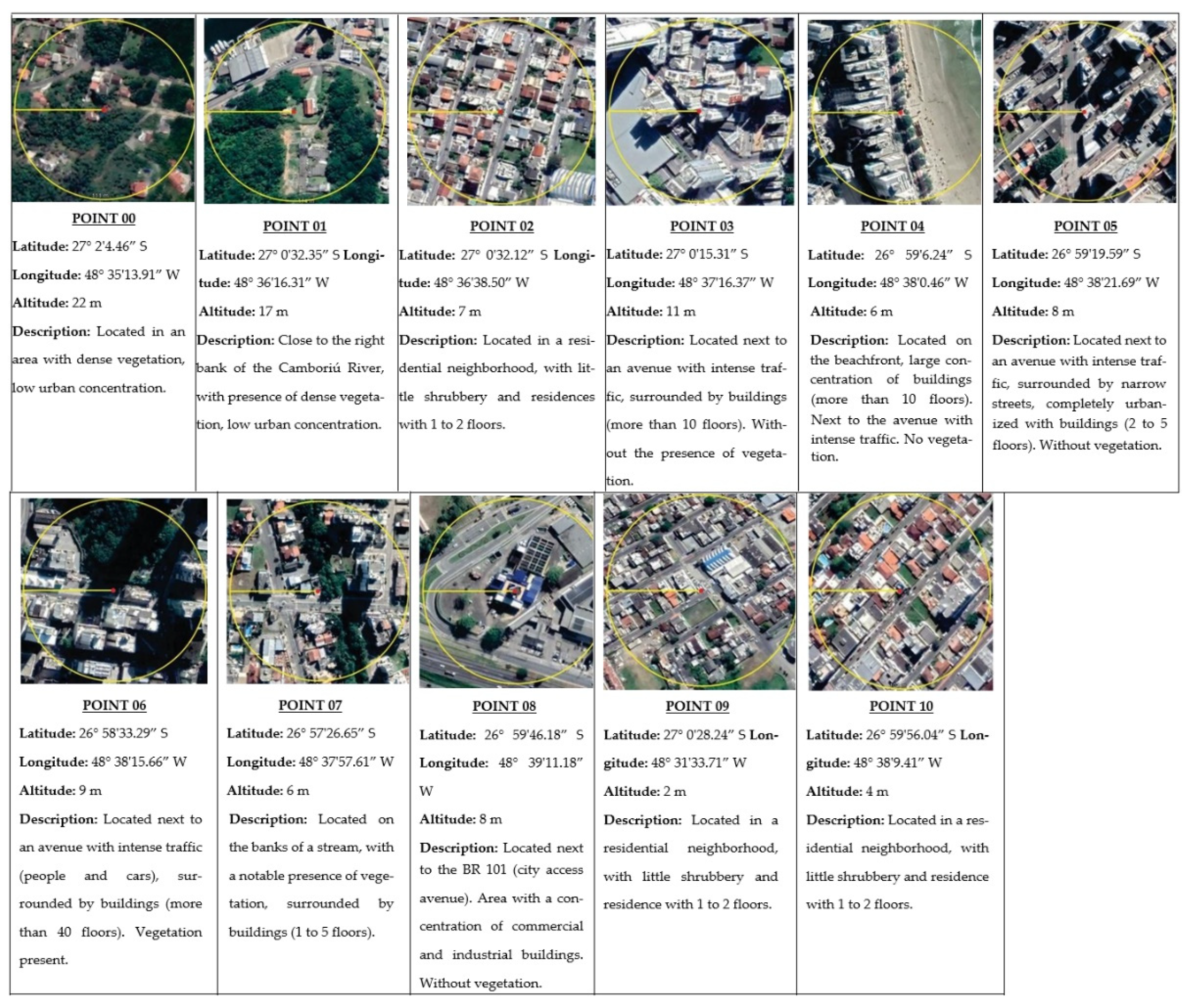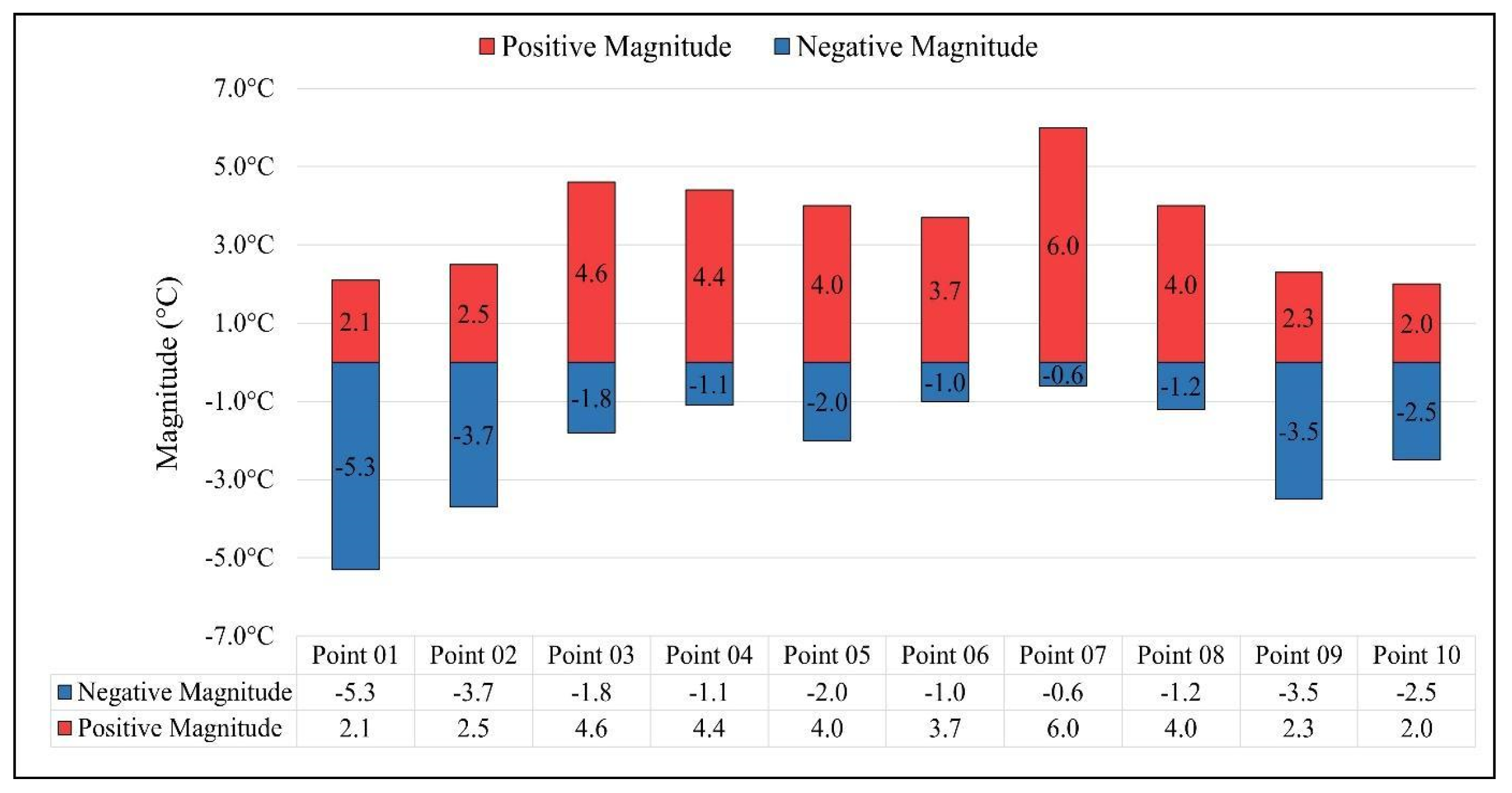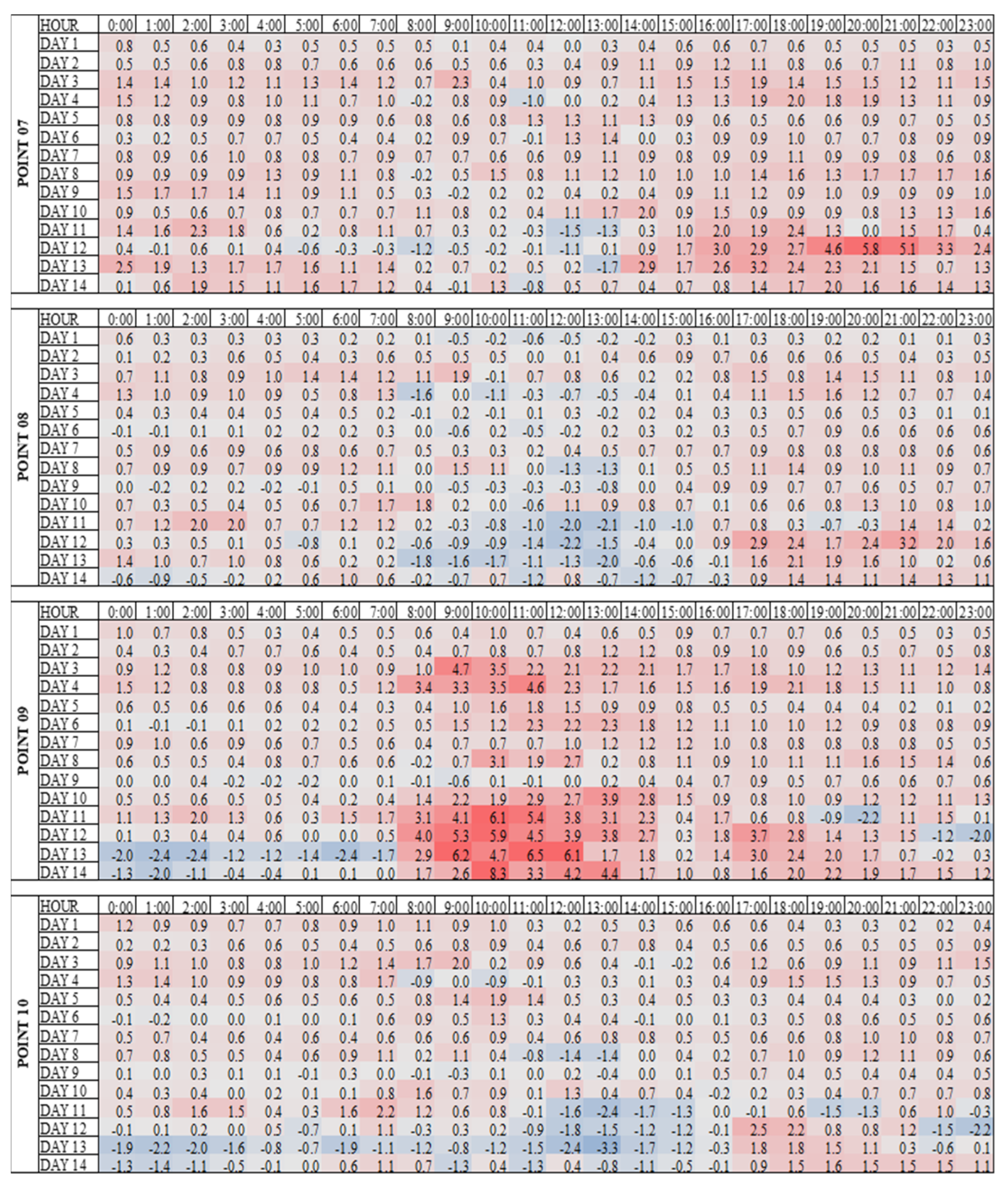Submitted:
19 April 2024
Posted:
22 April 2024
You are already at the latest version
Abstract
Keywords:
1. Introduction
2. Materials and Methods
2.1. Area Characterization
2.2. Points and Instruments Used for Collection
2.3. Analysis of the Magnitude of UHI and UCI
3. Results
3.1. LCZ in Balneário Camboriú
3.2. Ta data from Collection Points
3.3. Magnitudes of UHI and UCI in Balneário Camboriú
3.4. Relation of LCZs, Average Ta and Day and Night Magnitudes of the UHI/UCI at Each Point
4. Discussion
5. Conclusions
Author Contributions
Funding
Acknowledgments
Conflicts of Interest
References
- Tan, P.Y. & Hamid, A. R. B. A. Urban ecological research in Singapore and its relevance to the advancement of urban ecology and sustainability. Landscape and Urban Planning, 2014, 125, 271–289. [CrossRef]
- Oke, T.R. Boundary Layer Climates. Methuen, London, New York (1987).
- Gagliano, A.; Nocera; F.; Aneli, S. Computational Fluid Dynamics Analysis for Evaluating the Urban Heat Island Effects. Energy Procedia 2017, v. 134, p. 508-517.
- Wu, X.; Wang, G.; Yao, R.; Wang.; Yu, D.; Gui, X. Investigating Surface Urban Heat Islands in South America Based on MODIS Data from 2003–2016. Remote Sens. 2019, 11, 1212. [CrossRef]
- Nakata-Osaki, C. M.; Souza, L. C. L.; Rodrigues, D. S. THIS – Tool for Heat Island Simulation: A GIS extension model to calculate urban heat island intensity based on urban geometry. Computers, Environment and Urban Systems, v 67, 2018, p. 157-168. [CrossRef]
- Yang, C., Wang, R., Zhang, S., Ji, C., Fu, X. Characterizing the Hourly Variation of Urban Heat Islands in a Snowy Climate City during Summer. International Journal of Environmental Research and Public Health, 2019, 16(14), 2467. [CrossRef]
- Niu, L.; Tang, R.; Jiang, Y.; Zhou, X. Spatiotemporal Patterns and Drivers of the Surface Urban Heat Island in 36 Major Cities in China: A Comparison of Two Different Methods for Delineating Rural Areas. Sustainability 2020, 12, 478. [CrossRef]
- Quan, J. Multi-Temporal Effects of Urban Forms and Functions on Urban Heat Islands Based on Local Climate Zone Classification. Int. J. Environ. Res. Public Health 2019, 16, 2140. [CrossRef]
- Amorim, M.C.C.T.; Dubreuil, V. Intensity of Urban Heat Islands in Tropical and Temperate Climates. Climate 2017, 5, 91. [CrossRef]
- Amani-Beni, M.; Zhang, B.; Xie, G.-D.; Shi, Y. Impacts of Urban Green Landscape Patterns on Land Surface Temperature: Evidence from the Adjacent Area of Olympic Forest Park of Beijing, China. Sustainability 2019, 11, 513. [CrossRef]
- Leal-Filho, W.; Echevarria Icaza, L.; Emanche, V.O.; Zheng, Y.; Ren, C.; Xu, Y.; Wang, R.; Ho, J.; Lau, K.; Ng, E. GIS-based mapping of Local Climate Zone in the high-density city of Hong Kong. Urban Climate 2018, 24, 419–448. [CrossRef]
- Mandelmilch, M.; Ferenz, M.; Mandelmilch, N.; Potchter, O. Urban Spatial Patterns and Heat Exposure in the Mediterranean City of Tel Aviv. Atmosphere 2020, 11, 963. [CrossRef]
- Mohajerani, A.; Bakaric, J.; Jeffrey-Bailey, T. The urban heat island effect, its causes, and mitigation, with reference to the thermal properties of asphalt concrete. Journal of Environmental Management, 2017, 197, pp. 522-538. [CrossRef]
- Arnfield, A. J. Two decades of urban climate research: a review of turbulence, exchanges of energy and water, and the urban heat island. International Journal of Climatology: a Journal of the Royal Meteorological Society, 2003, 23(1), 1-26. [CrossRef]
- Yow, D. M. Urban heat islands: Observations, impacts, and adaptation. Geography Compass, 2007, 1(6), 1227-1251. [CrossRef]
- Gago, E. J.; Roldan, J.; Pacheco-Torres, R.; Ordóñez, J. The city and urban heat islands: A review of strategies to mitigate adverse effects. Renewable and sustainable energy reviews 2013, 25, 749-758. [CrossRef]
- Cakmakli, A. B., & Rashed-Ali, H. A Climate-Based Critical Analysis of Urban Heat Island Assessment Methods and Mitigation Strategies. Journal of Green Building, 2022, 17(4), 129-149. [CrossRef]
- Krüger, E., Drach, P., Emmanuel, R. Atmospheric Impacts on Daytime Urban Heat Island. Air, Soil and Water Research 2018, 11. [CrossRef]
- Jurus, P., Resler, J., Derbek, P., Krc, P., Belda, M., Benesova, N., Vlcek, O., Srbova, D., Eben, K., Hrubes, P. High resolution modelling of anthropogenic heat from traffic in urban canopy: A sensitivity study. Smart Cities Symposium Prague 2016, SCSP, art. no. 7501031. [CrossRef]
- Zhang, Q., Wu, Z., Guo, G. The cooling effect of water landscape in high-density urban built-up area a case study of the center urban district of Guangzhou.2nd International Conference on Frontiers of Sensors Technologies (ICFST), 2017 Shenzhen, 2017, pp. 394-400. [CrossRef]
- Stewart, I. D.; Oke, T. R. Local climate zones for urban temperature studies. Bulletin of the American Meteorological Society, 2012, v. 93, n. 12, p. 1879-1900. [CrossRef]
- Demuzere, M.; Kittner, J.; Bechtel, B. LCZ Generator: A Web Application to Create Local Climate Zone Maps. Front. Environ. 2012, Sci.9:637455. [CrossRef]
- Chieppa, J., Bush, A., & Mitra, C. Using “Local Climate Zones” to detect urban heat island on two small cities in Alabama. Earth Interactions, 2018, 22(16), 1-22. [CrossRef]
- Dimitrov, S., Popov, A., Iliev, M. An Application of the LCZ Approach in Surface Urban Heat Island Mapping in Sofia, Bulgaria. Atmosphere 2021, 12(11), 1370. [CrossRef]
- Anjos, M.; Lopes, A. Urban Heat Island and Park Cool Island Intensities in the Coastal City of Aracaju, North-Eastern Brazil. Sustainability 2017, 9, 1379. [CrossRef]
- Wollmann, C.A.; Gobo, J.P.A.; Chiquetto, J.P.; Shooshtarian, S.; Rotili Junior, D.H. Balneário Camboriú: The “Brazilian Dubai” and the Greatest Verticalization Process in the Southern Hemisphere. Bulletin of International Association for Urban Climate. 2020. Issue No. 78.
- Alvares, C.A.; Stape, J.L.; Sentelhas, P.C.; Gonçalves, J.L.M.; Sparovek, G. Köppen’s climate classification map for Brazil. Meteorol. Z. 2014, 22, 711–728. [CrossRef]
- Wollmann, C.A.; Hoppe, I.L.; Gobo, J.P.A.; Simioni, J.P.D.; Costa, I.T.; Baratto, J.; Shooshtarian, S. Thermo-Hygrometric Variability on Waterfronts in Negative Radiation Balance: A Case Study of Balneário Camboriú/SC, Brazil. Atmosphere 2021, 12, 1453. [CrossRef]
- Writzl, L., Wollmann, C. A., Costa, I. T., Gobo, J. P. A., Shooshtarian, S., & Matzarakis, A. (2022). Outdoor Human Thermal Comfort along Bike Paths in Balneário Camboriú/SC, Brazil. Atmosphere, 13(12), 2092. [CrossRef]
- Hoppe, IL, Wollmann, CA, Buss, AS, Gobo, JPA e Shooshtarian, S. Local Climate Zones, Sky View Factor and magnitude of daytime / nighttime urban heat islands in Balneário Camboriú, Sc, Brazil. Climate 2022, 10(12), 197. [CrossRef]
- IBGE Cidades@: Censo 2022. Available online: https://cidades.ibge.gov.br/brasil/sc/balneario-camboriu/panorama (accessed on 16 December 2023).
- Hoppe, I. L.; Wollmann, C.; Baratto, J. Performance de um novo modelo de abrigo meteorológico de baixo custo. Caminhos de Geografia, Uberlândia, v. 23, n. 86, p. 71–84, 2022.
- Garcia, F. F. Manual de climatologia aplicada: clima médio ambiente planificacion. Madrid, Síntesis, 1996. 285 p.
- Anjos, M.; Lopes, A.; Lucena, A. J.; Mendonça, F. Sea breeze front and outdoor thermal comfort during summer in northeastern Brazil. Atmosphere 2020, 11, 1013. [CrossRef]
- Mayer, H., Matzarakis, A., Iziomon, M. G. Spatio-temporal variability of moisture conditions within the urban canopy layer. Theor. Appl. Climatol. 2003, 76, 165–179. [CrossRef]
- Touchaei, A. G.; Wang, Y. Characterizing urban heat island in Montreal (Canada)—Effect of urban morphology. Sustainable Cities and Society, 2015, 19, 395-402. [CrossRef]
- Liu, Y., Li, Q., Yang, L., Mu, K., Zhang, M., & Liu, J. Urban heat island effects of various urban morphologies under regional climate conditions. Science of the total environment, 2020, 743, 140589. [CrossRef]
- Boccalatte, A., Fossa, M., Gaillard, L., & Menezo, C. Microclimate and urban morphology effects on building energy demand in different European cities. Energy and Buildings, 2020, 224, 110129. [CrossRef]
- Yuan, C., Adelia, A. S., Mei, S., He, W., Li, X. X., & Norford, L. (2020). Mitigating intensity of urban heat island by better understanding on urban morphology and anthropogenic heat dispersion. Building and Environment, 2020, 176, 106876. [CrossRef]
- Heisler, G. M., Brazel, A. J., The Urban Physical Environment: Temperature and Urban Heat Islands. Urban Ecosystem Ecology 2015, [S.l.], John Wiley & Sons, Ltd. p.29–56. [CrossRef]
- Amorim, M. C. C. T. Daily evolution of urban heat islands in a Brazilian tropical continental climate during dry and rainy periods. Urban Climate, 2020, v. 34. [CrossRef]









| Magnitude (°C) | Intensity | Category |
|---|---|---|
| > 6.0 | Very strong | UHI |
| 4.0 to 6.0 | Strong | |
| 2.0 to 4.0 | Moderate | |
| 0.0 to 2.0 | Weak | |
| -2.0 to 0.0 | Weak | UCI |
| -4.0 to -2.0 | Moderate | |
| -6.0 to -4.0 | Strong | |
| < -6.0 | Very strong |
| Ta (°C) | P00 | P01 | P02 | P03 | P04 | P05 | P06 | P07 | P08 | P09 | P10 |
|---|---|---|---|---|---|---|---|---|---|---|---|
| Average | 16.1 | 15.9 | 16.6 | 16.6 | 16.8 | 16.6 | 16.5 | 17.0 | 16.5 | 17.2 | 16.4 |
| Maximum | 23.6 | 23.3 | 24.9 | 22.3 | 24.5 | 22.6 | 23.9 | 24.6 | 22.9 | 28.8 | 22.7 |
| Minimum | 8.9 | 7.8 | 8.5 | 9.5 | 8.8 | 8.9 | 9.0 | 8.6 | 8.9 | 8.2 | 8.7 |
| Amplitude | 14.7 | 15.5 | 16.4 | 12.8 | 15.7 | 13.7 | 14.9 | 16.0 | 14.0 | 20.6 | 14.0 |
| AVERAGE (°C) | ||||||
|---|---|---|---|---|---|---|
| Point | LCZ | LCZ Influence |
Daily Ta | Night Ta | Daily Magnitude |
Night Magnitude |
| 01 | LCZ 9 | LCZ A and 8 | 17.4 | 14.5 | -0.3 | -0.2 |
| 02 | LCZ 3 | - | 18.4 | 15.1 | 0.7 | 0.4 |
| 03 | LCZ 1 | - | 17.5 | 15.7 | -0.1 | 1.0 |
| 04 | LCZ 1 | LCZ F | 18.1 | 15.5 | 0.5 | 0.8 |
| 05 | LCZ 3 | LCZ 1 | 17.6 | 15.6 | 0.0 | 0.9 |
| 06 | LCZ 1 | LCZ A | 17.7 | 15.4 | 0.1 | 0.7 |
| 07 | LCZ 6 | LCZ A | 18.4 | 15.8 | 0.8 | 1.1 |
| 08 | LCZ 8 | - | 17.7 | 15.4 | 0.1 | 0.7 |
| 09 | LCZ 3 | - | 19.3 | 15.2 | 1.6 | 0.5 |
| 10 | LCZ 3 | - | 17.9 | 15.1 | 0.3 | 0.4 |
Disclaimer/Publisher’s Note: The statements, opinions and data contained in all publications are solely those of the individual author(s) and contributor(s) and not of MDPI and/or the editor(s). MDPI and/or the editor(s) disclaim responsibility for any injury to people or property resulting from any ideas, methods, instructions or products referred to in the content. |
© 2024 by the authors. Licensee MDPI, Basel, Switzerland. This article is an open access article distributed under the terms and conditions of the Creative Commons Attribution (CC BY) license (http://creativecommons.org/licenses/by/4.0/).





